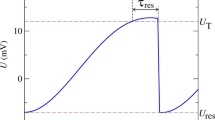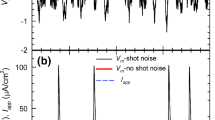Abstract
We explore the effects of stochastic sodium (Na) channel activation on the variability and dynamics of spiking and bursting in a model neuron. The complete model segregates Hodgin-Huxley-type currents into two compartments, and undergoes applied current-dependent bifurcations between regimes of periodic bursting, chaotic bursting, and tonic spiking. Noise is added to simulate variable, finite sizes of the population of Na channels in the fast spiking compartment.
During tonic firing, Na channel noise causes variability in interspike intervals (ISIs). The variance, as well as the sensitivity to noise, depend on the model's biophysical complexity. They are smallest in an isolated spiking compartment; increase significantly upon coupling to a passive compartment; and increase again when the second compartment also includes slow-acting currents. In this full model, sufficient noise can convert tonic firing into bursting.
During bursting, the actions of Na channel noise are state-dependent. The higher the noise level, the greater the jitter in spike timing within bursts. The noise makes the burst durations of periodic regimes variable, while decreasing burst length duration and variance in a chaotic regime. Na channel noise blurs the sharp transitions of spike time and burst length seen at the bifurcations of the noise-free model. Close to such a bifurcation, the burst behaviors of previously periodic and chaotic regimes become essentially indistinguishable.
We discuss biophysical mechanisms, dynamical interpretations and physiological implications. We suggest that noise associated with finite populations of Na channels could evoke very different effects on the intrinsic variability of spiking and bursting discharges, depending on a biological neuron's complexity and applied current-dependent state. We find that simulated channel noise in the model neuron qualitatively replicates the observed variability in burst length and interburst interval in an isolated biological bursting neuron.
Similar content being viewed by others
References
Agmon A, Connors B (1989) Repetitive burst-firing neurons in the deep layers of mouse somatosensory cortex. Neurosci. Lett. 99: 137-141.
Arvanitaki A, Chalazonitis N (1967) Electrical properties and temporal organization in oscillatory neurons (Aplysia). In: Neurobiology of Invertebrates. Plenum: Salanki, New York, pp. 169-199.
Bal T, Nagy F, et al. (1988) The pyloric central pattern generator in crustacea: A set of conditional neuronal oscillators. J. Comp. Physiol. 163: 715-727.
Braun H, Huber M, et al. (2000) Interactions between slow and fast conductances in the Huber/Braun model of cold-receptor discharges. Neurocomputing 32: 51-59.
Braun H, Wissing H, et al. (1994) Oscillation and noise determine signal transduction in shark multimodal sensory cells. Nature 367: 270-273.
Braun HA, Huber MT, et al. (2001) Noise-induced impulse pattern modifications at different period-one situations in a computer model of temperature encoding. Biosystems 62(1-3): 99-112.
Braun HA, Huber MT, et al. (1998) Computer simulations of neuronal signal transduction: the role of nonlinear dynamics and noise. Int. J. Bifurcation and Chaos 8(5): 881-889.
Calvin WH, Stevens CF (1968) Synaptic noise and other sources of randomness in motoneuron interspike intervals. J. Neurophysiol. 31: 574-587.
Chow CC, White JA (1996) Spontaneous action potentials due to channel fluctuations. Biophys. J. 71: 3013-3021.
Collins JJ, Chow CC, et al. (1995) Stochastic resonance without tuning. Nature 376: 236-238.
Conti F, Wanke E (1975) Channel noise in nerve membranes and lipid bilayers. Quarterly Reviews of Biophysics 8(4): 451-506.
Cymbalyuk GS, Gaudry Q, et al. (2002) Bursting in leech heart interneurons: Cell-autonomous and network-based mechanisms. J. Neurosci. 22(24): 10580-10592.
Elson RC, Huerta R, et al. (1999) Dynamical control of irregular bursting in an identified neuron of an oscillatory circuit. J. Neurophysiol. 82: 115-122.
Faure P, Korn H (1997) A nonrandom dynamic component in the synaptic noise of a central neuron. Proc. Natl. Acad. Sci. USA 94(12): 6506-6511.
Feudel U, Neiman A, et al. (2000) Homoclinic bifurcation in a Hodgkin-Huxley model of thermally sensitive neurons. Chaos 10(1): 231-239.
Fox RF (1997) Stochastic versions of the Hodgkin-Huxley equations. Biophysical Journal 72(5): 2068-2074.
Fox RF, Lu Y (1994) Emergent collective behavior in large numbers of globally coupled independently stochastic ion channels. Phy. Rev. E 49(5): 3421-3431.
Guckenheimer J, Rowat PF (1997) Dynamical systems analyses of real neuronal networks. In: PS Stein, S Grillner, AI Selverston and DG Stuart, eds. Neurons, Networks, Motor Behavior, MIT Press, pp. 151-163.
Hartline DK, Russell DF (1984) Endogenous burst capability in a neuron of the gastric mill pattern generator of the spiny lobster Panulirus interruptus. J. Neurobiol. 15(5): 345-364.
Hille B (2001) Ion Channels of Excitable Membranes, 3rd ed. Sunderland, Mass., Sinauer.
Hodgkin AL, Huxley AF (1952) A quantitive description of membrane current and its applications to conductiion and excitation in nerve. J. Physiol. (Lond.) 116: 500-544.
Hunter J, Milton J (2003) Amplitude and frequency dependence of spike timing: implications for dynamic regulation. J Neurophysiol. 90: 387-394.
Hunter J, Milton J, Thomas PJ, Cowan JD (1998) Resonance effect for neural spike time reliability. J Neurophysiol. 80: 1427-1438.
Hutcheon B, Yarom Y (2000) Resonance, oscillation and the intrinsic frequency preferences of neurons. Trends Neurosci. 23(5): 216-222.
Izhikevich E (2000) Neural excitability, spiking, and bursting. Int. J. Bifurcations and Chaos 10(6): 1171-1266.
Kandel E, Spencer W (1961) Electrophysiology of hippocampal neurons. II. After-potentials and repetitive firing. J. Neurophysiol. 24: 243-259.
Kantz H, Schreiber T (1997) Nonlinear Time Series Analysis. Cambridge, Cambridge University Press.
Kay AR, Sugimori M, Llinas R (1998) Kinetic and stochastic properties of a persistent sodium current in mature guinea pig cerebellar purkinje cells. J. Neurophysiol. 80(3): 1167-1179.
Kepecs A, Wang X-J (2000) Analysis of complex bursting in cortical pyramidal neuron models. Neurocomputing 32/33: 181-187.
Kepler TB, Marder E, Abbott LF (1990) The effect of electrical coupling on the frequency of model neuronal oscillators. Science 248(4951): 83-85.
Kiehn O (1991) Plateau potentials and active integration in the 'final common pathway' for motor behavior. TINS 14(2): 68-73.
Klink R, Alonso A (1993) Ionic mechanisms for the subthreshold oscillations and differential electroresponsiveness of medial entorhinal cortex layer-II neurons. J Neurophysiol. 70: 144-157.
LeCar H, Nossal R (1971) Theory of threshold fluctuations in nerves. II. Analysis of various sources of membrane noise. Biophysical. J 11: 1068-1084.
Mainen ZF, Sejnowski TJ (1995) Reliability of spike timing in neocortical neurons. Science 268(9 June): 1503-1506.
Mainen ZF, Sejnowski TJ (1996) Influence of dendritic structure on firing pattern in model neocortical neurons. Nature 382(6589): 363-366.
Mino H, Rubinstein JT, White JA (2002) Comparison of algorithms for simulation of action potentials with stochastic sodium channels. Annals of Biomed. Eng. 30: 578-587.
Neiman A, Schimansky-Geier L, Moss F, Shulgin B, Collins JJ (1999) Synchronization of noisy systems by stochastic signals. Phys. Rev. E 60: 284-292.
Oldeman BE, Krauskpof B, et al. (2000) Death of period-doublings: Locating the homoclinic-doubling cascade. Physica. D 146(1-4): 100-120.
Pinsky PF, Rinzel J (1994) Intrinsic and network rhythmogenesis in a reduced Traub model for CA3 neurons [published erratum appears in J. Comput. Neurosci., 1995 Sep; 2(3): 275]. Journal of Computational Neuroscience 1(1/2): 39-60.
Rinzel J (1987) A Formal Classification of Bursting Mechanisms in Excitable Systems. In: 1986 International Congress of Mathematicians, American Mathematics Society.
Rinzel J, Ermentrout B (1998) Analysis of neural excitability and oscillations. In: Koch C, Segev I, eds. Methods in Neuronal Modelling, Cambridge, Mass., MIT Press.
Rubinstein J (1995) Threshold fluctuations in N sodium channel model of the node of Ranvier. Biophys. J 68: 779-785.
Russell DF, Hartline DK (1982) Slow active potentials and bursting motor patterns in pyloric network of the lobster, Panulirus interruptus. J. Neurophysiol. 48(4): 914-937.
Schneidman E, Freedman B, Segev I (1998) Ion channel stochasticity may be critical in determining the reliability and precision of spike timing. Neural Comput. 10: 1679-1703.
Selverston AI, Moulins M, eds. (1987) The Crustacean Stomatogastric System. Berlin Heidelberg, Springer-Varlag.
Sigworth FJ (1980) The variance of sodium current fluctuations at the node of Ranvier. J. Physiol. 307: 97-129.
Simiu E (2002) Chaotic Transitions in Deterministic and Stochastic Dynamical Systems. Princeton, New jersey, Princeton University Press.
Skaugen E, Walløe L (1979) Firing behaviour in a stochastic nerve membrane model based upon the Hodgkin-Huxley equations. Acta Physiologica Scandinavica 107(4): 343-363.
Stevens C, Zador A (1998) Input synchrony and the irregular firing of cortical neurons. Nature Neurosci. 1: 210-217.
Strassberg AF, DeFelice LJ (1993) Limitations of the Hodgkin-Huxley formalism: Effects of single channel kinetics on transmembrane voltage dynamics. Neural Computation 5(6): 843-855.
Terman D (1991) Chaotic spikes arising from a model of bursting in excitable membranes. SIAM J. Appl. Math. 51(5): 1418-1450.
Terman D (1992) The transition from bursting to continuous in excitable membrane models. J. Nonlinear Science 2: 135-182.
Traub RD, Wong RK, Miles R, Michelson H (1991) A model of a CA3 hippocampal pyramidal neuron incorporating voltage-clamp data on intrinsic conductances. J Neurophysiol. 66(2): 635-650.
Ulrich D (2002) Dendritic resonance in rat neocortical pyramidal cells. J Neurophysiol. 87: 2753-2759.
Wang X-J (1993) Genesis of bursting oscillations in the Hindmarsh-Rose model and homoclinicity to a chaotic saddle. Physica D 62: 263-274.
Wang X-J, Rinzel J (1995). Oscillatory and bursting properties of neurons. In: MA Arbib, ed. Handbook of Brain Theory and Neural Networks, MIT Press. pp. 686-691.
White J, Budde T, Kay AR (1995) A bifurcation analysis of neuronal subthreshold oscillations. Biophys J. 69: 1203-1217.
White JA, Klink R, Alonso A, Kay AR (1998) Noise from voltage-gated ion channels may influence neuronal dynamics in the entorhinal cortex. J. Neurophysiol. 80: 262-269.
White JA, Rubinstein JT, Kay AR (2000) Channel noise in neurons. Trends Neurosci. 23(3): 131-137.
Author information
Authors and Affiliations
Rights and permissions
About this article
Cite this article
Rowat, P.F., Elson, R.C. State-Dependent Effects of Na Channel Noise on Neuronal Burst Generation. J Comput Neurosci 16, 87–112 (2004). https://doi.org/10.1023/B:JCNS.0000014104.08299.8b
Issue Date:
DOI: https://doi.org/10.1023/B:JCNS.0000014104.08299.8b




